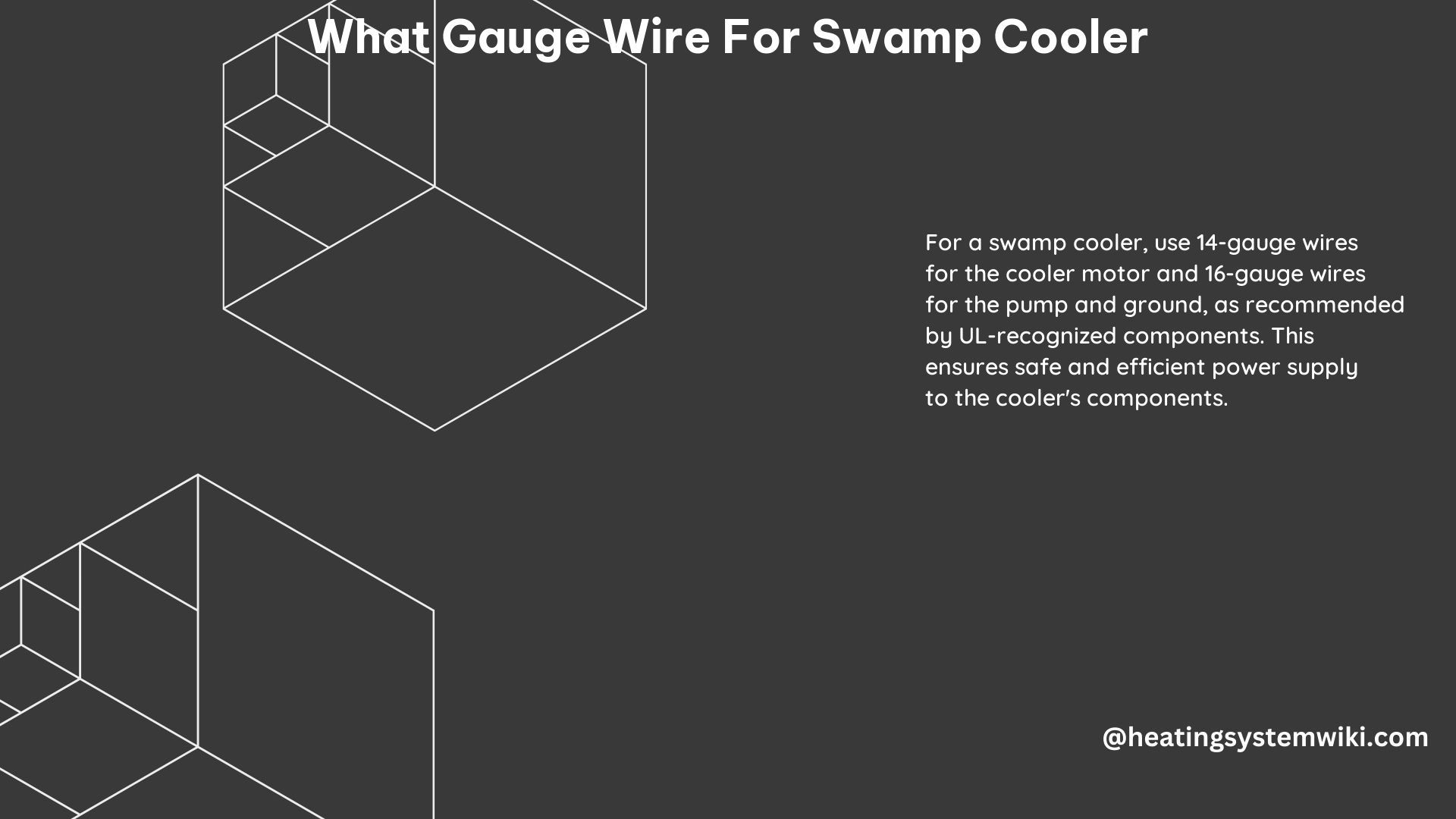When it comes to wiring a swamp cooler, the choice of wire gauge is crucial for ensuring the safe and efficient operation of your cooling system. The recommended wire gauge for a swamp cooler is typically 14 gauge for the motor wires and 16 gauge for the pump and ground wires. These wires are often included in swamp cooler control cables that can be ordered by the foot. It is important to ensure that the wiring is compatible with the voltage of the swamp cooler, which can be either 115 or 230 volts.
Understanding Wire Gauge for Swamp Coolers
The wire gauge, also known as the American Wire Gauge (AWG), is a standardized system used to measure the diameter of electrical wires. The lower the number, the thicker the wire. For example, a 14 gauge wire has a larger diameter than a 16 gauge wire, and it can carry more current.
When it comes to swamp coolers, the motor wires typically require a 14 gauge wire to handle the higher current draw of the motor. The pump and ground wires, on the other hand, can be safely wired with a 16 gauge wire, as they carry a lower current.
It’s important to note that using the wrong wire gauge can lead to several issues, such as:
- Voltage Drop: If the wire gauge is too small, it can cause a significant voltage drop, leading to reduced motor performance and potential damage to the cooler’s components.
- Overheating: Undersized wires can overheat, posing a fire hazard and potentially damaging the cooler’s electrical system.
- Inefficient Operation: Improper wire gauge can result in reduced airflow and cooling efficiency, as the motor may not be able to operate at its full capacity.
Swamp Cooler Wiring Color Codes

When wiring a swamp cooler, it’s essential to pay attention to the color-coding of the wires to ensure proper connections. The standard color-coding for swamp cooler wiring is as follows:
| Wire Color | Function |
|---|---|
| Black | Hot wire for high-power setting |
| Green | Ground wire |
| Red | Low wire for low-power setting |
| White | Common wire or neutral |
| Yellow | Water pump wire |
These wires should be connected to the appropriate terminals on the switch and the cooler to ensure the proper operation of the swamp cooler.
Hiring a Professional for Swamp Cooler Wiring
If you are not comfortable with wiring or are unsure about the process, it is recommended to hire a professional electrician to wire your swamp cooler switch. A professional can ensure that the wiring is done correctly and up to professional standards, which can help prevent electrical issues and ensure the safe and efficient operation of the swamp cooler.
When hiring a professional, look for someone with experience in swamp cooler wiring and who is familiar with the local electrical codes and regulations. They should be able to provide a detailed quote, including the cost of materials and labor, and should be willing to explain the wiring process to you.
Swamp Cooler Control Cable Specifications
Swamp cooler control cables are often used to connect the various components of the cooling system, such as the motor, pump, and switch. These cables are typically available in 14 gauge for the motor wires and 16 gauge for the pump and ground wires.
When ordering a swamp cooler control cable, be sure to specify the following details:
- Wire Gauge: 14 gauge for motor wires, 16 gauge for pump and ground wires
- Number of Wires: Typically 5 wires (black, green, red, white, yellow)
- Cable Length: Order the cable by the foot to match your specific installation requirements
Some popular swamp cooler control cable options include:
- Swamp Cooler Control Cable 14 Gauge 5 Wire – Order by the Foot SJT145
- DIAL 10 ft. Evaporative Cooler Whip 7555
Conclusion
In summary, the recommended wire gauge for a swamp cooler is 14 gauge for the motor wires and 16 gauge for the pump and ground wires. It is important to pay attention to the color-coding of the wires and ensure that they are connected to the appropriate terminals on the switch and the cooler. If you are not comfortable with wiring, it is recommended to hire a professional to wire your swamp cooler switch to ensure the safe and efficient operation of your cooling system.
References:
- Indoor Comfort Supply. (n.d.). Swamp Cooler Control Cable 14 Gauge 5 Wire – Order by the Foot SJT145. Retrieved from https://indoorcomfortsupply.com/swamp-cooler-control-cable-14-gauge-5-wire-order-by-the-foot-sjt145/
- General Metals. (n.d.). COOLER PARTS. Retrieved from https://www.generalmetals.com/content/DM7548.pdf
- The Home Depot. (n.d.). DIAL 10 ft. Evaporative Cooler Whip 7555. Retrieved from https://www.homedepot.com/p/DIAL-10-ft-Evaporative-Cooler-Whip-7555/100345877
- DIY Stack Exchange. (2017, July 17). Connecting the motor to 12/2 wire and a 6 position dial in an evaporative swamp cooler. Retrieved from https://diy.stackexchange.com/questions/119578/connecting-the-motor-to-12-2-wire-and-a-6-position-dial-in-an-evaporative-swamp
- PIEC. (2021, February 25). How to Wire an Evaporative Swamp Cooler Switch: Wiring Diagram. Retrieved from https://piec.com/how-to-wire-an-evaporative-swamp-cooler-switch-wiring-diagram/.
